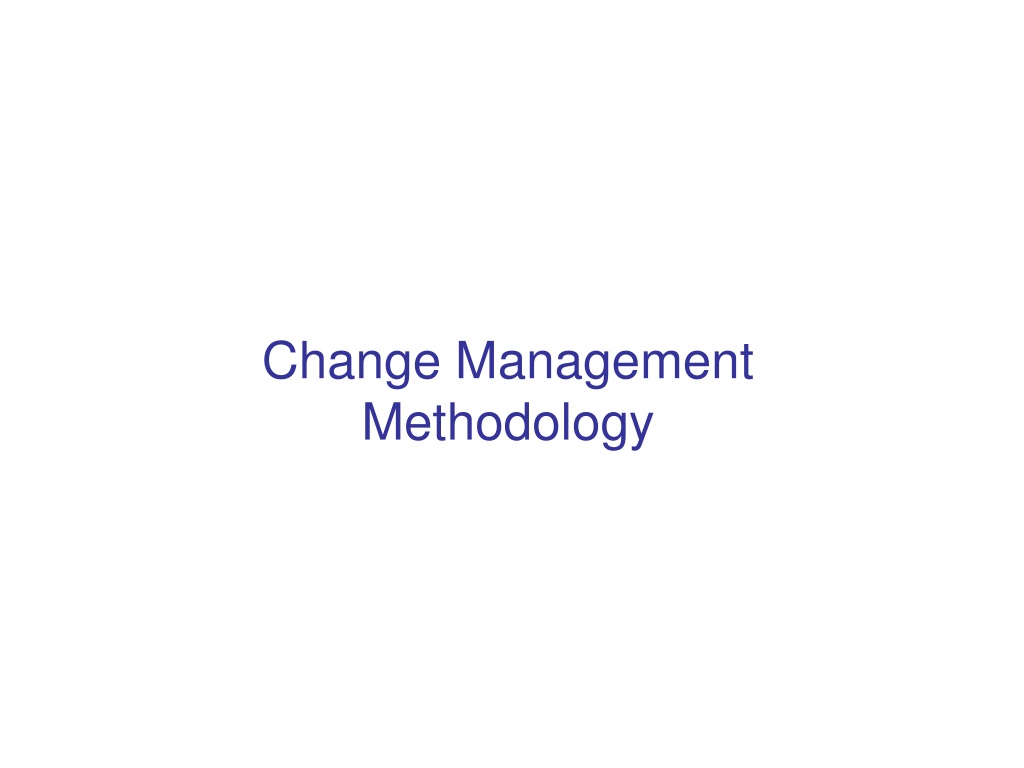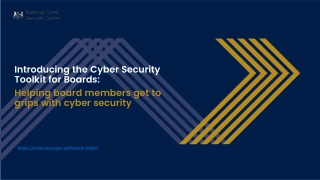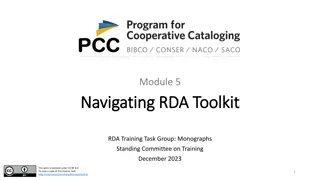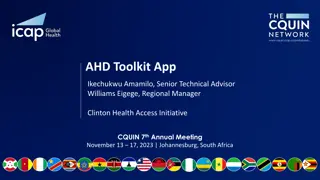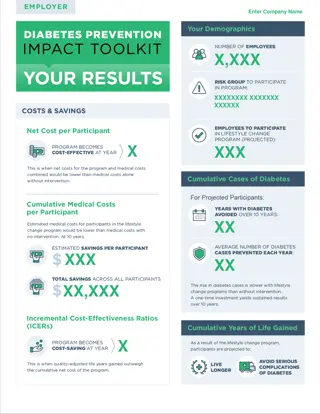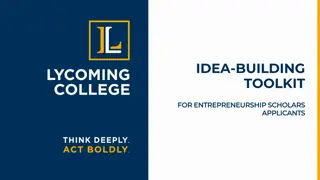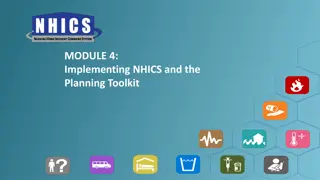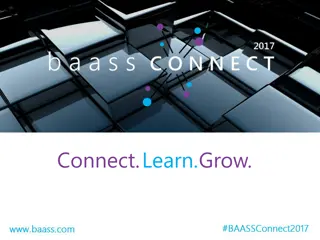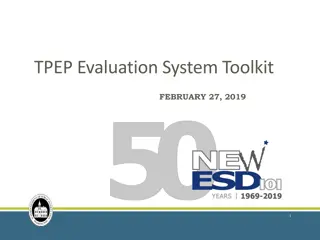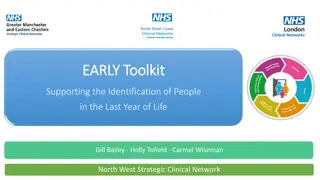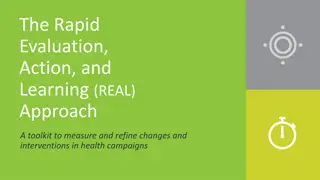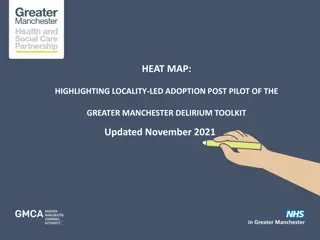Effective Change Management Methodology Toolkit
This methodology toolkit provides practical strategies for sponsors and change agents to identify and overcome natural barriers to change initiatives within their organizations. It outlines a structured approach divided into typical change route stages, field theory concepts, elements, phases, and practical tools to support successful change implementation by defining roles, assessing readiness, building commitment, and creating critical mass effect.
Download Presentation

Please find below an Image/Link to download the presentation.
The content on the website is provided AS IS for your information and personal use only. It may not be sold, licensed, or shared on other websites without obtaining consent from the author.If you encounter any issues during the download, it is possible that the publisher has removed the file from their server.
You are allowed to download the files provided on this website for personal or commercial use, subject to the condition that they are used lawfully. All files are the property of their respective owners.
The content on the website is provided AS IS for your information and personal use only. It may not be sold, licensed, or shared on other websites without obtaining consent from the author.
E N D
Presentation Transcript
Change Management Methodology
What is it? A toolkit to help Sponsors and Change Agents understand and identify the various natural barriers to change initiatives in their organisations and practical strategies to ensure implementation success.
Context Typical Change Route Presenting Situation Data Collection & Analysis Solution Design and Testing Implementation Planning Monitoring & Review Approval Implementation Good change management accelerates this
Field Theory Current State Desired State Transition State Restraining Forces Enabling Forces Field Theory: Kurt Lewin
Change Management usefully sectioned into 9 elements Defining the Change Leadership Culture Alignment Change Readiness Being an Effective Sponsor Current State Desired State Being an Effective Change Agent Appropriate Change Approach Building Commitment Support Infrastructure Critical Mass Effect
And 3 phases Defining the Change Preparing Leadership Culture Alignment Change Readiness Being an Effective Sponsor Enabling Being an Effective Change Agent Appropriate Change Approach Building Commitment Doing & Reviewing Support Infrastructure Critical Mass Effect
With practical tools to help Project Initiation Document Defining the Change Leadership Culture Alignment Impact of Change Assessment Change Readiness Change Health-check Culture & Readiness Assessment Being an Effective Sponsor Being an Effective Change Agent Sponsor & Change Agent Assessment Appropriate Change Approach Building Commitment Commitment Mapping Support Infrastructure Stakeholder Analysis and Critical Mass Assessment Critical Mass Effect
Identifies clear roles in implementing change Authorising Sponsor The person who authorises an initiative, has the positional power to make it happen and is singularly accountable for it s success. Champion(s) A committed enthusiast for the change who may be in a position of influence to guide/lead the change agents but ultimately doesn t have the power of the authorising sponsor. Change Agents The person, or people, responsible for managing the implementation of the initiative. May be a Project Manager and/or implementation team. Reinforcing Sponsors Stakeholders who report to the Authorising Sponsor and become equally committed and reinforce the initiative in their areas. Stakeholders Those who will be directly or indirectly impacted by the initiative or who are interested and can influence the outcome. They typically evolve in their response to the initiative from Engagement, Incubation, (Resistance/Apathy?), Transition then to Commitment.
How to use this guide Each of the following sections have three parts: Definition Explains what is meant by this element of change management and any background or examples of associated theory that contributes to our understanding. Common Barriers Highlights what typically can go wrong or is overlooked when this element of change management is undertaken. Enablers Tips to help overcome barriers and/or provide impetus towards the desired change. Going through each section and applying the theory and tools as appropriate for a particular change initiative: Allows a clearer picture to be developed about specific implementation barriers and enablers. Helps to define practical change management activities that can be undertaken to accelerate change. Enables a cohesive change plan to be built that can then be progressed and monitored.
Defining the Change Leadership Culture Alignment Change Readiness Being an Effective Sponsor Current State Desired State Being an Effective Change Agent Appropriate Change Approach Building Commitment Support Infrastructure Critical Mass Effect
Defining the Change The key starting point of any change initiative is developing collective clarity about what exactly the change means and why it is being carried out. This typically requires the creation a project initiation document, terms of reference or other proposal type document. This clarifies the scope of the change initiative but the process allows the Sponsor and Change Agents the opportunity to challenge, clarify and collectively understand the what, why, how, who and when of the change. I.e. It s not just the document itself that s important, the process used for creating it and the people involved in this are both key. Deciding involvement level at this stage is an important balancing act: Positives Negatives Early opportunity for wider set of stakeholders to understand the drivers for this change, influence and feel part of it. Need to be prepared to listen and change the pet solution. Debating is a slow process. May also confuse any required legal consultation process. Wide involvement Quick definition and decisions about the change. Clear boundary between development and consultation. Quality of decisions may suffer. May encounter later difficulties in getting buy in from people who feel they should have been involved earlier. Narrow involvement
Impact on service users? Impact on wider functions, departments or teams? Impact on staff roles? Change Identified NO NO NO YES YES YES Secure appropriate level sponsor Involve appropriate clinical / care governance groups Alert HR and agree support requirements NHS GG&C Change Involvement Guide Engage local Staff Side / Union Representative Involve appropriate public / patient involvement groups Note: Observe the Greater Glasgow & Clyde policies on Managing Workforce Change available via HR or on the HR area of Staffnet. Consider inequalities impact and alert CIT if support required Significant resistance anticipated from stakeholders? Involves a service redesign ? Complex service change with multiple dependencies? Requires a shift in organisation/staff capabilities? NO NO NO NO YES YES YES YES Alert OD & L&E and agree support requirements Alert Planning function and agree support requirements Ensure adequate service redesign skills are applied Alert OD and agree support requirements Consider EQIA and alert E&D team if support required Apply Change Mgt Methodology
Defining the Change - Common Barriers 1. No clear or shared description of the scope and detail of the change between the Sponsor and Change Agents. 2. Baseline data/information not detailed or accurate enough. 3. No commonly held belief amongst the key players about the compelling case for the initiative or where it fits within the overall strategy. 4. True scale or nature of the change required is misunderstood or misleading. 5. Lack of understanding about what the change means for impacted individuals or groups, and how these people may react. 6. Direct and indirect costs and risks of the initiative have not been fully quantified. 7. Expected benefits have not been clearly quantified (service, financial, people, process). 8. Project scope neglects to cover all technical, business and human change elements. 9. Benefit or outcome phasing is unclear. (Benefits or outcomes may be expected immediately on commencement of the change or may not come through till later. Cost/benefit ratio may be very high up front.) 10. Benefit or outcome tracking, reporting and reviewing mechanisms not in place so no clarity about when the change has actually been implemented or benefits delivered against baseline.
Defining the Change - Enablers 1. Ensure that the sponsor and change agents have common clarity and detailed understanding about the present position, the desired position and the change journey. 2. If the compelling case for this initiative isn t obvious then this needs to be set out in a way that is meaningful for all and presents an engaging vision of the future. 3. Carry out an Impact of Change Assessment to determine the nature and extend of impact on all Stakeholders. 4. Check that this project is one of the top priorities of the Sponsor and Change Agents and it is directly or indirectly reflected in their personal objectives. If not then the validity of this project at this time must be questioned. 5. Ensure that project management disciplines are in place to plan all aspects of the project and monitor implementation progress. (For larger initiatives this usually means having an implementation team, clear workstreams, project plan and project governance structure and routines). 6. Agree and set out the benefits/outcomes tracking and review mechanisms.
Defining the Change Leadership Culture Alignment Change Readiness Being an Effective Sponsor Current State Desired State Being an Effective Change Agent Appropriate Change Approach Building Commitment Support Infrastructure Critical Mass Effect
The Cultural Onion Behaviours Values Assumptions (Adapted from models proposed by both Geert Hofstede and Fons Trompenaars)
Culture: Broad Types Outward looking Values: Values: Customer responsiveness Change and agility New ideas and approaches Shaping future success Entrepreneurship Thinking big picture Playing for the house Taking accountability Competitive challenge Setting tough targets Hard work & effort Sense of urgency Logic and data Getting results Delivery Culture Growth Culture Stability Flexibility Values: Values: Human contribution Development of people Recognition & reward Leadership integrity Team development Diversity Employee health & wellbeing Processes & procedures Policies & compliance Measures & controls Process Culture People Culture Stability Planning Infrastructure Technology Inward looking Adapted from Competing Values Framework (Cameron & Quinn 1999)
Leadership Culture Alignment If an initiative directly challenges the organisations culture or local subculture then the change management effort required by the Sponsor and Change agents will be substantial. Culture is extremely pervasive. At its core are assumptions built up through time that are subconsciously acted upon and extremely hard to change. Existing culture is reinforced by the leadership in an organisation because they have found success in the current way and have the most to lose if it changes. Culture change is extremely resource and time consuming and perhaps impossible to achieve directly. Working on the visible or behavioural outer layers may eventually shape the inner values and assumptions through time. Need to try and understand the culture as much as possible (which is also difficult if you are part of it) so that effort can be made to achieve a level of alignment between the prevailing culture and this change initiative.
Leadership Culture Alignment - Common Barriers 1. The concept of organisation culture, it s reinforcement by leadership, and it s effect on change initiatives is poorly understood by the Leader and Change Agents. 2. Awareness of the culture or subcultures presently existing in the organisation is low. 3. There is poor understanding amongst the Sponsor and Change Agents as to why the present culture prevails. 4. The key players have good culture awareness but are unsure how (or unwilling) to challenge it. 5. This change project, or some elements within it, directly challenge current cultural norms and behaviours. 6. Thinking that the culture has to somehow change first before this initiative can be implemented. 7. Sponsor and Change Agents assume that what has worked in other organisations (or other parts of this organisation) will automatically work here.
Leadership Culture Alignment - Enablers 1. Build awareness amongst the Sponsor and Change Agents of the culture/subcultures in the organisation and the power these can exert. 2. Focus on culture alignment not culture change. Culture change may occur as a result of the initiative becoming embedded. 3. Exploit the elements of the culture that align well with the change and focus Sponsor effort on tactics to negotiate around the barriers. Work to pre-empt what these barriers may look like. 4. Use highly visible and compelling reinforcement tactics to start to generate a critical mass of commitment.
Defining the Change Leadership Culture Alignment Change Readiness Being an Effective Sponsor Current State Desired State Being an Effective Change Agent Appropriate Change Approach Building Commitment Support Infrastructure Critical Mass Effect
Change Readiness Initiative Load How many other initiatives are competing for the same resource and people s attention? How many initiatives can the organisation cope with at the one time? Where does this project sit in the overall list of priorities, and how does it contribute to the direction and strategy? Change Fatigue History of change implementation in the organisation; is there a record of successful change? What has been implemented well and why? Have initiatives failed or been de-scoped in the past? Why? Will this initiative be seen as the next flavour of the month? Generally are people tired or uncomfortable with change or do they embrace it? Is there confidence in the senior people to lead change well? Past successes are deposits in the change account, past failures are withdrawals. How healthy is the balance?
Sponsorship Poor Change Definition Change Agents Change Approach High Initiative Load Building Commitment High Change Fatigue Support Infrastructure Poor alignment with culture Critical Mass INITIATIVE SUCCESS INITIATIVE FAILURE
Change Readiness - Common Barriers 1. Assuming that another initiative can be absorbed by the organisation when resources are already stretched. 2. Numerous no.1 priorities have spread resources so thinly that none of them are progressing. 3. The organisation is change weary . 4. Past implementation failures have created widespread cynicism across the organisation and low confidence in leadership. This is often especially pronounced amongst professionals who tend to stay with an organisation whereas managers (usually responsible for driving the change) move on. 5. Thinking that this change will be successful by doing the same things that failed before.
Change Readiness - Enablers 1. Focus on the vital few priorities that are most directly linked to the organisations strategy. All others are distractions that dilute resource and effort. 2. Take a programme approach to co-ordinate and review all organisation initiatives. 3. Examine past implementation successes and failures and the contributing factors. Build on strengths and work on the problem areas. 4. Work to get high profile quick wins within a change initiative to increase the confidence that this time things are different.
Defining the Change Leadership Culture Alignment Change Readiness Being an Effective Sponsor Current State Desired State Being an Effective Change Agent Appropriate Change Approach Building Commitment Support Infrastructure Critical Mass Effect
Being an Effective Sponsor Strength of sponsorship is the most influential factor for determining implementation success. Strong leadership from the authorising sponsor will overcome most barriers to change in an organisation. The sponsor of the initiative must have the organisational power to make things happen, however, sponsor resource is also scarce, so looking too high in the organisation for a sponsor of a small initiative is wasteful. Rule of thumb: Authorising Sponsor: The person at the lowest point in the organisation structure to which all impacted employees report. Sponsor effectiveness depends on three elements: What is Expressed What is Modelled (EMR) What is Reinforced
All three need to be aligned Expressed Modelled Reinforced Low Impetus for changeHigh Expressed: The sponsor promotes dissatisfaction with the current state, presents a compelling case for change and describes the future in a way that engages people. Modelled: The sponsor lives the new state with high profile demonstrations of personal change. More powerful if it is also personally painful for the sponsor. Reinforced: The sponsor applies reward and recognition to others for changing, as well as negative consequences for not changing, using both formal and informal means.
The Sponsors Role Agrees and authorises the scope and definition of the change initiative. Appoints change agents with the right skills (project manager/team). Releases required resources. (Budget, people, facilities etc.) Defines and applies the appropriate change strategy. Sets progress targets for the change. Authorises the support infrastructure. Encourages commitment (using EMR) towards critical mass. Motivates the Change Agents and regularly reviews their performance. Aligns their recognition and reward. Monitors and reviews progress of the initiative and the benefits/outcomes against target.
Being an Effective Sponsor - Common Barriers 1. Sponsor role is vague, either not appointed or perhaps sponsorship by the management committee . 2. The wrong sponsor has been appointed and although committed to the project doesn t have the power or authority to lead it. (c.f. Champion role) 3. The sponsor is unaware of their responsibilities and the importance of their leadership impact on the project s success. 4. Sponsor delegates their role to the change agents. 5. The sponsor s rhetoric is not matched by action or reinforcement. (Sometimes these are directly opposite) 6. Sponsor s rhetoric or actions are neither inspiring nor meaningful for people. 7. Sponsor s efforts are stretched by too many initiatives.
Being an Effective Sponsor - Enablers 1. The Sponsor must be convinced of and committed to the case for change and they must express, model and reinforce the new state in a way that reaches out and compels people to commit to the change. 2. If sponsor commitment is low, influence them by finding out and appealing to their frame of reference. Also, engage committed peers, direct reports and trusted confidantes. 3. Can this project be aligned to one or more of the Sponsor s personal objectives? 4. Can this project be linked to (e.g. an enabler of) another project that has strong sponsorship. 5. Contract with the Sponsor about their role and what you need them to so to ensure the initiative s success. 6. Ensure the Sponsor becomes aware of any pockets of resistance or apathy. 7. If Sponsor access is an issue (e.g. due to seniority) then utilise a more senior reinforcing sponsor or champion to approach them.
Defining the Change Leadership Culture Alignment Change Readiness Being an Effective Sponsor Current State Being an Effective Change Agent Desired State Appropriate Change Approach Building Commitment Support Infrastructure Critical Mass Effect
Being an Effective Change Agent If the Sponsor has accountability for the change, the Change Agent has responsibility for implementation. Change Agents may be the project manager, the implementation team or anyone looking after the implementation of the project. Change Agents must be selected wisely for their technical expertise but also for a range of other key skills: Strong technical/functional knowledge Strong change management and project management skills Strong interpersonal and team skills Commitment, drive and tenacity Political awareness and influencing skills Trust and credibility with the sponsor and stakeholders. Ideally a track record of success.
Being an Effective Change Agent - Common Barriers 1. Wrong Change Agent(s) appointed based on availability rather than capability. 2. Change Agents appointed for their technical or functional skills but fall short in the other key skills. 3. Change Agents not committed to, or unaware of, the compelling case for the change initiative. 4. Not enough resource allocated, or conflicting priorities. 5. Change Agents unsupported by the Sponsor or poor infrastructure. 6. Reward and recognition not aligned.
Being an Effective Change Agent - Enablers In selecting and managing Change Agents the sponsor must: 1. Select the best Change Agent(s) to implement this project which usually means sacrificing something else. 2. Make the selection based on the full list of characteristics not just technical skills. 3. Ensure adequate resource allocated for implementation and where possible make full time roles, avoiding conflicts with other projects or line roles. 4. Ensure that this project is incorporated in the change agent s personal objectives and that reward and recognition systems are aligned. Use both formal and informal reinforcement to ensure change agent motivation. 5. Regularly review change agent performance and implement any development requirements, including team development. 6. Ensure that the change agents have the necessary tools, technology and supporting infrastructure to get the job done.
Defining the Change Leadership Culture Alignment Change Readiness Being an Effective Sponsor Current State Appropriate Change Approach Desired State Being an Effective Change Agent Building Commitment Support Infrastructure Critical Mass Effect
Appropriate Change Approach Rather than a change starting , change can be viewed as the ending of an old state, the beginning of a new state with a transition state in the middle. Humans gain comfort from the status quo and time and effort is required to allow people to accept change and move on in a stable way. In the transition state people have psychologically let go of the past and are ready to commit to a future state. If change is forced upon people without this transition being accommodated then the change may take place but people will revert back to the previous more comfortable state at the earliest opportunity. Deciding and implementing the appropriate change approach is a critical role of the Sponsor and cannot be delegated. The Sponsor must play the active part in encouraging stakeholders into transition using aligned EMR. The transition state should only be circumvented where quick compliance is essential e.g. critical health & safety or quality issues, where there is no time for discussion or prolonged engagement. The transition phase must then be handled afterwards in order to make the new state stable. Transition and Hammer approaches are in themselves neither right nor wrong, it s the decision (or lack of) to use one or the other that has important consequences.
Transition Productivity / Morale Transition Incubation Desired State (stable) Current State Resistance Hammer Incubation Transition Desired State (unstable) Current State Resistance Productivity / Morale (Drawn from work of both Kurt Lewin and William Bridges)
Appropriate Change Approach - Common Barriers 1. Same change approach employed (usually hammer) time after time irrespective of conditions or requirements. 2. Transition strategy employed as lip-service only. 3. Key players unaware of the consequences of over-use of hammer approach, resulting in constant management fire fighting to retain compliance with past changes resulting in a poor climate for any further change. 4. Sponsor unaware of their role in the transition approach.
Appropriate Change Approach - Enablers 1. Generate awareness amongst Sponsor and Change Agents of the different change approaches and their applications. 2. Decide whether quick compliance or long term commitment is required. 3. Make a conscious decision on which approach to employ for each initiative then be open about it to all Stakeholders. (Honesty and openness builds trust). 4. If using the Hammer then remember about Transition later.
Defining the Change Leadership Culture Alignment Change Readiness Being an Effective Sponsor Current State Desired State Being an Effective Change Agent Appropriate Change Approach Building Commitment Support Infrastructure Critical Mass Effect
Building Commitment A measure of the level of buy in to the change initiative. Must understand the human psychological response to change in order to help people move quickly to Transition and then to Commitment. Resistance is a natural response to any change. It is a function of the disruption that change brings and is not necessarily logical or linked only to negative change. Resistance can be managed only if it is surfaced. If it is brushed aside or handled aggressively it will not go away, it will retreat underground and cause unseen damage to the initiative in ways that are more difficult to manage. Must create a climate and level of confidence in people that allows them to speak up and voice their genuine concerns or worries. Must listen, explore and acknowledge peoples concerns. This doesn t mean bowing to the pressure and softening the change but acknowledging and respecting that different people have different frames of reference (FOR). Commitment is most powerfully built from the Sponsor down (using EMR) however if Sponsor commitment or effectiveness is an issue then commitment may have to be encouraged to spread out organically from pockets in the organisation.
Towards Commitment Motivation towards the future state COMMITMENT RESISTANCE APATHY Time
Sponsor Tactics Engagement Clarity of the message for all. Business case. Compelling need. Vision of the future. Impact of change. Commitment Monitor and review the change. Support the change agents. Keep the motivation and momentum going. Recognise and reward Incubation Sponsor availability. Repeat the messages. Allow time. Open up all networks. Transition Explore the vision of the future in more detail. Clarify the first steps and milestones. Light the way . Prepare the change agents. Resistance Nurture the resistance, allow it to come out and explore it. Positively acknowledge people for stating their doubts. Don t soften the change unless new (real) information comes out. Try to get underneath any fogging to find out real reasons for resistance. Remember frames of reference.
The Grieving Phases* (Negative Change) Past focus Future focus Emotional Response ANGER ACCEPTANCE DEPRESSION Time (* From On Death & Dying , Elisabeth Kubler-Ross)
Sponsor Tactics Anger Allow and acknowledge the anger. Give people time and space. Acceptance Acknowledge the sacrifices that have been made. Support people in their new direction. Denial Restate the messages. Business case. Impact of change. Bargaining Don t soften the change unless new and real information comes to light. Restate the change. Exploration Help people explore their options. Present possible future and positive scenarios. Provide support for changes. Depression Allow people to grieve . Listen and provide support. Gather feedback and review support.
Commitment Map - Ideal Sponsor 1st 2nd 2nd 2nd 2nd 3rd 3rd 3rd 3rd 3rd 3rd 3rd 3rd 3rd 3rd 3rd 4th 4th 4th 4th 4th 4th 4th 4th 4th 4th 4th 5th 5th 5th 5th 5th 5th 5th 5th 5th 5th 5th Commitment Incubation/resistance
Common Mistake Middle management missed out Sponsor 1st ? ? ? ? ? ? ? ? ? ? ? ? ? ? ? ? ? ? ? ? ? ? ? ? ? ? 2nd 2nd 2nd 2nd 2nd 2nd 2nd 2nd 2nd 2nd 2nd Commitment Incubation/apathy/resistance
Wrong sponsor 1st Sponsor 2nd 3rd 3rd 3rd 4th 4th 4th 5th 5th 5th Commitment Incubation/apathy/resistance
No sponsor, informal network Commitment Incubation/apathy/resistance
